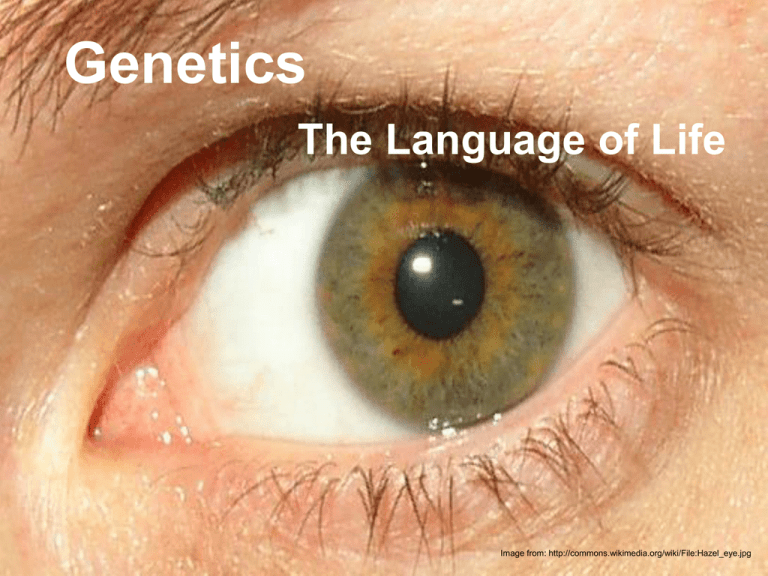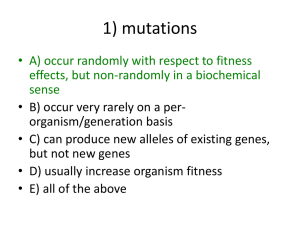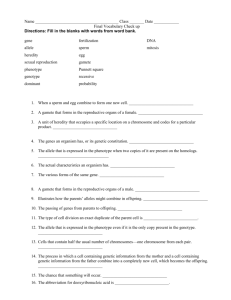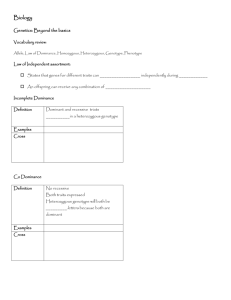Genetics The Language of Life Image from:
advertisement

Genetics The Language of Life Image from: http://commons.wikimedia.org/wiki/File:Hazel_eye.jpg Define Genetics! Genetics, The Unit • How these genes are passed from generation to generation. (inherited) • How genes affect the way we look and Function. • What’s the probability of a gene being inherited? • How we can manipulate genes to get desired outcomes Genetics, Clarified How we get the Genes we get (Genes?) Gene: A section of DNA that encodes for a trait. (Trait?) Trait: Information communicated by the DNA. Sometimes obvious (eye color), sometimes hidden (enzymes). The gene is a sequence of the DNA, the trait is what the DNA encodes for, or “makes”. Alleles: The different “forms” a gene may have For example: Eye color Important point: a gene actually encodes for a protein. “One gene: one protein” Organization in the Nucleus http://commons.wikimedia.org/wiki/File:Chromosomes.JPG http://upload.wikimedia.org/wikipedia/commons/9/91/Chromosome.gif • Long strands of chromatin condense into chromosomes. • The sister chromatids are the result of replication. • Each chromatid has the same base sequence • Histone proteins act as spools Chromosomes Chromosomes are generally represented as being shaped like an “X”. They are actually 2 chromatids joined Chromatid together like conjoined twins. The result of replication of one chromatid The shorter part of the “X” is the “p” arm The spot where the 2 chromatids join is called the centromere The longer part of the “X” is the “q” arm How many? Most of the cells in our body have 46 (23 pair) chromosomes. Exception: Our Gametes (egg and sperm) have 23 single chromosomes How many? Gametes (haploid) Diploid Zygote (fertilized egg) Some Vocabulary • Gene Section of DNA that codes for a trait (actually, they code for protein strands but more on that later) • Allele Different “forms” of a gene (brown eyes vs. blue eyes) • Zygote fertilized egg (alleles in pairs) • Gamete sex cells i.e. sperm and eggs (single alleles) Mendel http://www.nlm.nih.gov/visibleproofs/media/detailed/vi_a_201.jpg A monk and his peas • Mid 19th century Austrian • Developed a basic understanding of inheritance of traits. • Followed traits in generations of pea plants http://upload.wikimedia.org/wikipedia/commons/b/b7/Snow_Pea_on_Plant.JPG Following the Traits http://commons.wikimedia.org/wiki/File:Mendel_seven_characters.svg Mendel’s “Laws” • Genes for traits come in pairs (one from each parent). • Law of dominance – one gene (allele) can prevent the appearance of another gene (allele). • Law of segregation – when gametes form, pairs of genes separate so each gamete gets one of each gene pair. • Law of independent assortment – During gamete formation, genes for different traits separate independently of one another. More Vocabulary • Heterozygous Having different alleles in an allelic pair (Bb) AKA hybrid • Homozygous Both alleles in the pair are the same (BB, bb) AKA pure • Dominant The allele that is expressed (shown) in a heterozygous pair of alleles • Recessive The allele that is NOT expressed in the heterozygous pair of alleles Even More Vocabulary • Phenotype The physical traits that are expressed in an individual e.g. brown eyes • Genotype The alleles present in an individual e.g. BB or Bb *Phenotype does not always show genotype Brown eyes = BB or Bb So how do we figure out our genotype? More on that…next class For instance: Homozygous red What’s the genotype? RR The phenotype? Red What’s the genotype? Heterozygous red The phenotype? What’s the genotype? Homozygous white The phenotype? Rr Red rr White








